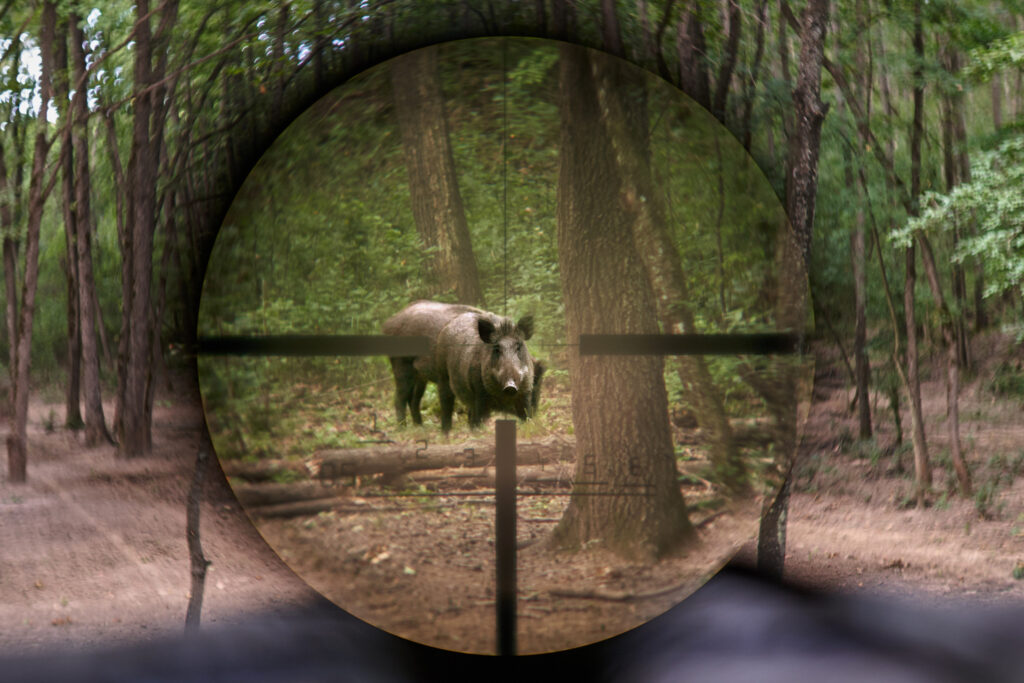
Hog hunting during the day can be an exciting and challenging experience for those who enjoy the thrill of the hunt. Feral hogs can cause significant damage to agricultural crops and natural habitats, making it important to manage their populations. In addition to being a necessary practice, hog hunting can also be a fun and rewarding activity for hunters of all levels.
In this article, we will explore some tips and techniques for hunting hogs during the day, including scouting locations, selecting appropriate gear, and tracking and taking down your prey. Whether you are a seasoned hunter or a beginner, this guide will help you prepare for a successful hog-hunting adventure.
What Kind Of Damage Do They Do?
Crops
Because they eat both meat and vegetables, feral hogs are omnivores. They dig through the ground to find food since they are ravenous eaters.
They will consume almost any food, including corn, grains, soybeans, peanuts, rice, and the majority of other ingredients. Nevertheless, they do not even need to consume the crops to harm them because they root, tramp, and wallow all reduce the crops to a useless mess.
Livestock
Up to 40 different diseases that can infect both humans and cattle are known to be carried by feral hogs. Notwithstanding the fact that swine flu was eradicated from the US in 1978, there is still a persistent worry that feral hogs will infect a population of pigs.
They also prey on weaker animals, like young and sick ones. And if that weren’t bad enough, hogs frequently pollute livestock’s feed and water, rendering those resources useless and infecting the cattle with the disease.
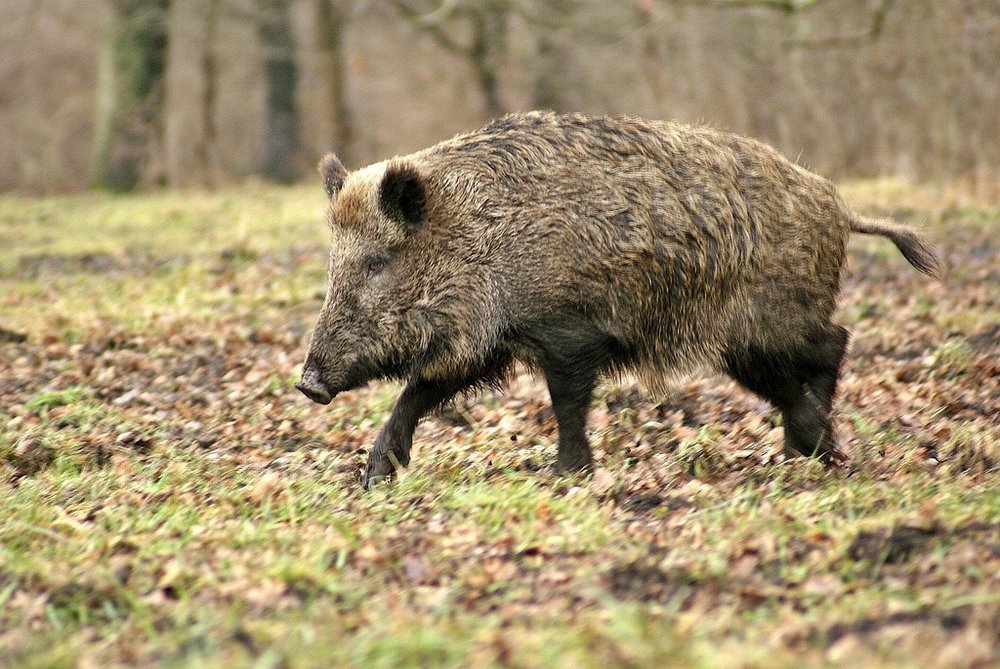
Pasture
As weeds frequently emerge to replace the crops that hogs eat, good grazing land is also harmed by hogs. Through all of their roots, they also harm the earth.
Also, all of these ruts can make it very challenging for farmers to operate tractors over their fields to collect their crops.
Property Damage
Other people besides just those in the agriculture sector can also be harmed by hogs. Hogs will ruin peoples’ lawns, gardens, and fences as they search for food.
They also cause harm to parks, cemeteries, and beaches. Finally, when they are involved in collisions, they frequently result in car damage.
Horticulture
Hogs can injure a variety of plants, not just crops. They’ll also go for orchards, wineries, and plant nurseries. In addition to eating the plants, they will damage irrigation systems and other essential pieces of machinery for maintaining the orchard or nursery. Moreover, they remove tree bark, leaving trees susceptible to disease.
Variables to Consider When Hunting Wild Hog
Location
Despite reports of hogs in 45 states across the nation, they are more common in the southeastern borders. So, it should come as no surprise that hog populations are abundant in places like Texas, Florida, and Georgia. Hogs often like dense brush and muddy terrain.
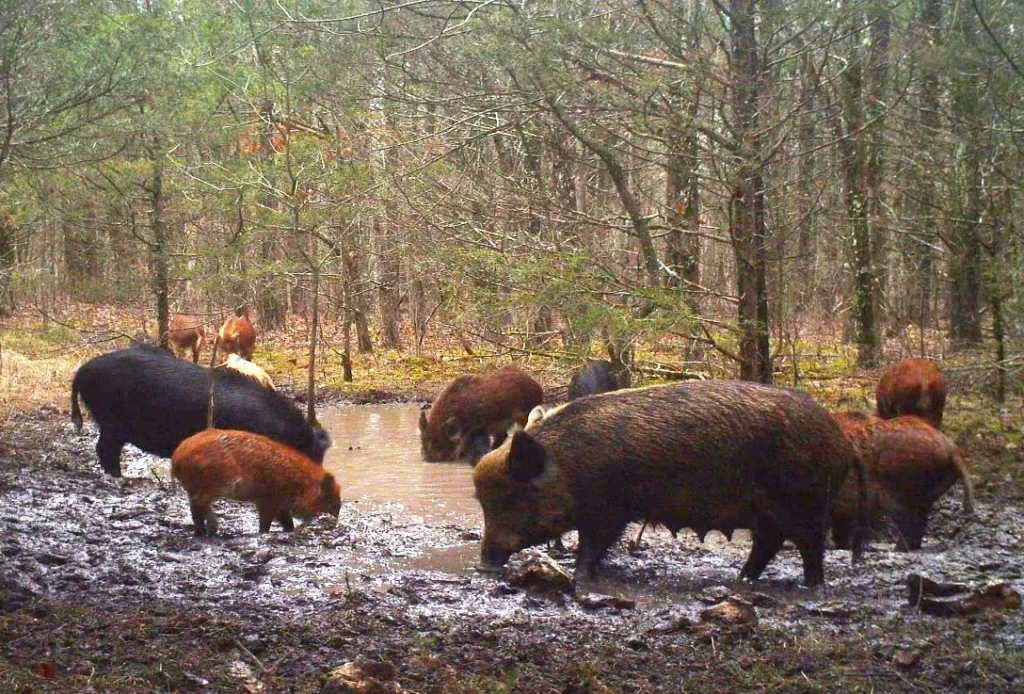
Time of Day
Early morning or late night is typically when hogs are most active. They might, however, be just as busy in the middle of the day if you are daytime hunting in the winter. This is because they are actively seeking out food.
Solunar Calendar
The position and fullness of the moon have an impact on animal movement, according to a theory put out by John Alden Knight in 1926. Before Knight’s idea was published, it was rumored that hunters and fishers employed this theory, which is still extensively used today.
Temperature
As previously indicated, the colder weather drives hogs to travel further and for a longer period of time in quest of food. Hog hunting is best when it’s freezing early in the morning or late at night since hogs require more food to stay warm when it’s chilly outside.
Barometric Pressure
Another crucial element to take into account when hog hunting is barometric pressure because it has an impact on how hogs detect your scent. While high-pressure systems allow your message to ascend, lower pressure will keep it close to the ground. On days with less hunting pressure, think about using a stand.
General Weather Conditions
Even though hogs can be hunted in most weather patterns, finding hogs in motion is best done with a light rain or cold front. Nevertheless, if the wind is blowing too hard, it can hurt your chances of bringing one home.
Time of Year
Although it is permitted to shoot hogs every day of the year, many hunters believe that the deer season immediately after is the finest time of year to hunt wild hogs. Because they are more active and travel farther and longer in quest of food, the months of December through February are the ideal time for hog hunting.
Wind
The bloodhounds of the American game are hogs. Although deer have an exceptional sense of smell, a wild board surpasses them. With their keen sense of smell, wind can be particularly challenging to hunt. Make sure the area you choose to hunt is downwind of them.
What Is The Best Time Of Day To Hunt Hogs?
How do we go about hunting hogs now that we have some background knowledge?
Just after sunrise and right before sunset is the best time to hunt hogs. This is so that they can rest for the day as hogs usually forage at night when they are on their way back to their sleeping quarters.
This, however, is not a set rule. They will become increasingly active throughout the day due to environmental conditions.
As pigs do not sweat, they are more prone to go outside in the warmest part of the day when it is really hot.
In contrast, they are more likely to be rooting throughout the day in really cold weather because the lower temperatures enable them to move more quickly and across greater distances. Kids can move around more easily at this period.
What is the Best Time to Hog Hunt in Florida?
Although hog hunting is permitted throughout the whole year in Florida, many hunters believe that the ideal time to hunt the state’s feral pigs is during the winter. Hog hunting specialists claim that during this time of year, hogs in the Sunshine State frequently invade oak hammocks to eat the simple stashes of acorns they scoop up from the forest floor.
Hog hunting in Florida is an adventure that cannot be matched anywhere else. Only Texas has a larger feral hog population than Florida, which is astounding. According to reports, there are at least 500,000 hogs in the state, and they have been discovered in each of the 67 counties in Florida.
At an estimated 7.6 hogs per square mile compared to Texas’ 5.58 hogs per square mile, Florida has a higher hog population density than Texas. The largest hog population densities are typically found in areas with extensive vegetation and close proximity to a body of water.
Hogs begin to relocate into creek bottoms, depression marshes, and palmetto flats to take root as the supply of acorns in Florida’s forest floors starts to decline. They now plow the ground in search of any digestible plant or animal materials.
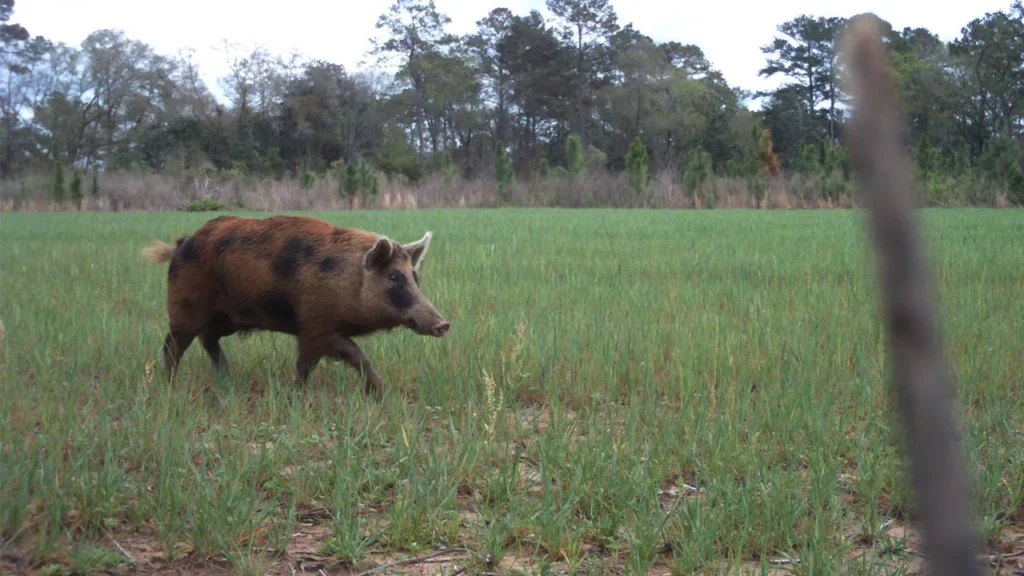
Hogs tend to consume more and for longer periods of time since the weather in Florida is colder in the late winter and early spring. It should be noted that the hunter now has a better probability of finding a sounder. In order to maintain their energy during the chilly days, they are also more likely to visit feeder locations early in the day.
Florida’s winter is unquestionably the dry season, which means you are less likely to encounter muddy lowlands and swampy places. As there is less greenery now, the vision will be better. You should also think about the time of day if you want to hunt hogs in Florida.
Hogs are more active at night during the winter because they are foraging more aggressively than ever.
Having the proper hue hog hunting lights is essential, say, experts, for a successful nighttime hog hunt in Florida. Early morning and early evening are good times to see hogs feeding if you are unprepared for a night hunt. Indeed, successful daytime hog hunting is possible on the unpressured territory.
The pigs will almost immediately become nocturnal once hunters start to exert pressure on the land. Indeed, you might have a fantastic success time for hog hunting during the day, but if you intend to hunt the area again soon, a night hunt might be the best option.
Night hunting
Hogs have adapted to hunter behavior by going nocturnal as hog hunting has gained popularity as a means of population control. The best time to hunt hogs is at night while they are feeding because of their nocturnal propensity. The appropriate hue-hog hunting lights are essential for a successful nighttime hunt in Florida. These lights consist of
- Bow light for hog hunting: If you want to use a bow for hunting hogs, you should think about doing so at night. This will not only give you better chances, but the correct bow light will also allow you to illuminate the hogs without drawing their attention. You need a bow hunting light made for hogs’ color blindness in order to be successful at this.
- Hog hunting light bar: If you intend to use a swamp buggy, ATV/UTV, high rack, or even hunt from your deer blind, a light bar for hog hunting will help you have more productive hog hunting excursions. The hog hunting light bar must be created at the ideal wavelength for color blindness in hogs, just like with the bow light.
- Gun light for hog hunting: For hog hunting, a correctly made bow light or light bar can also be utilized as a pistol light. It should be noted that the capacity to shine at farther distances—outside of 300 yards—is a primary necessity for gun lights. Many high-quality light bars and bow lights are capable of this function.
Texas
Texas is a popular hunting location in the US, with an estimated 1.5 million hogs. One of the main reasons why wild hog hunting has become more and more popular in Texas is the area’s lax rules and regulations. This, together with the significant number of feral hogs, keeps hog hunters active all year long.
The greatest hog hunting seasons in Texas must be known, though, if you prefer to go hog hunting during a particular period of time or season. Although you can theoretically hunt pigs here all year long, there are certain times of year that are better than others for doing so. To learn more about it, keep reading.
Winter season (December-February)
In Texas, December through February is generally regarded as the prime wild hog hunting season. Winter is the season with the coldest temperatures. In pursuit of additional food, pigs emerge during this time of day. Because of the chilly weather, hogs are constantly looking for food.
Less spotting expertise is required for hog hunting during the day than at night. In contrast to the dark, when sighting requires specialized equipment, a hog is considerably simpler to locate and target in the light of day.
This season, wild pigs even don’t hesitate to venture farther in quest of food. The greater their release, the greater your probability of seeing them. The ideal time to see pigs is in the middle of the day. The best temperature for wild pigs is now when the sun is still up. As a result, if you choose this time to go wild hog hunting in South Texas, you should expect better results.
Spring season (March-May)
The spring season in Texas is the next best time of year for hog hunting after the winter. The good weather benefits hunters even though you might not anticipate seeing as many pigs during this season as you would typically see throughout the winter.
You can anticipate hogs to venture outside in quest of food at all hours of the day and even at night due to the favorable weather conditions. By utilizing the appropriate feeders, you may get hogs’ attention.
Yet, the majority of Texas’ wild boar hunting guides would advise you to be cautious in April. This is because November is Texas’ windiest month, which enhances the possibility that hogs will use their excellent sense of smell to find a hunter. The situation may worsen if a hog notices a hunter and puts them at risk of being attacked by unusual wild creatures.
Summer season (June-August)
Especially during the daytime, feral hogs do not leave their habitats as frequently in the summer as they do in the winter. The ideal strategy for successful hog hunting in the summer is to go out at night.
Special optical gear would be required for nighttime hog hunting. To increase your chance of hunting hogs, you must learn how to use them effectively.
Where Are Wild Hogs During The Day?
In their natural habitat, hogs would snooze for up to 12 hours a day in nests constructed of leaves and straw. But, when they are not sleeping, you can find them in dense forests full of opportunities to find food like berries, roots, and grubs.
Since they can locate more food sources in open grasslands, they can also be found there. Every creek, lake, or body of water will undoubtedly have hogs visiting it at different times of the day because they need to drink water and cool off during the day.
What Attracts Wild Hogs?
The main draw for hogs is food, particularly maize. Because corn is a mainstay in hogs’ diets, it is by far the most popular bait used for hog hunting.
The corn can be distributed in a number of methods, with some people using timed feeders and others using a gunny sack that drips it to the ground.
You can also use a post digger to dig holes in the ground, fill them with corn, and then leave the hogs to follow their natural curiosity and dig them up.
Adding sugar to the corn improves the effectiveness of the bait. You may add natural sugars to beer, Kool-Aid, coffee packets, pancake syrup, and even lager to make it almost enticing to hogs. This is because hogs love sugar and need a lot of it for energy.
There are also many calls available today, but these have at best received inconsistent responses. Although other types of bait, such as sugar cane and soybeans, also help to attract hogs, baiting with corn remains the most effective way.
How Long Does It Take For Hogs To Find Bait?
Using traps is one of the most popular ways to hunt. Although there are many different types and sizes of traps, they all use bait. But, you cannot simply spread out bait and expect hogs to start coming in the following day. They need to be trained.
It could take a hog a week or even up to a month to find the bait or feel secure enough to consume it when you initially start baiting. Over time, when you acclimate the local hogs to the bait, they can arrive in as little as a day or as long as a week.
It’s important to take care not to overhunt a region with bait since hogs may learn to avoid it and become less likely to eat the bait in the future.
Can Wild Hogs Smell Humans?
Wild hogs possess a keen sense of smell. Their sense of smell is much more acute than that of deer, according to scientific studies. Using a good scent remover is advised for any hunting because pigs can even detect human scent for several days after we leave an area.
How Do You Hunt Hogs During The Day?
Hunting hogs during the day brings special difficulties that are not present when hogs prefer to forage for food at night. But fear not—the helpful advice and methods listed below will make your daytime hog hunt equally as productive as your overnight one.
Tracking Hogs During the Day
There are a few obvious indications that hogs are close. They would follow the most obvious one. Yet, there would be a second one rutting and rising from the ground.
Here are a few more warning indicators to watch out for:
- Ruts and rises in the ground
- Fresh excrements
- Patches of mud
If there are fresh ruts and rises in the ground, this can be a sign that hogs are searching for food nearby. Another excellent indicator is excrement, especially if it is fresh.
Oatmeal should be the consistency of fresh hog waste. Finally, muddied holes indicate that hogs choose that location for cooling off wallowing.
Calls
A predator call would be the most effective form of a call to employ for hogs. Coyote-like calls are excellent for luring hogs out of hiding and into the open.
When utilizing this technique, be careful to maintain a safe distance because it will terrify the hogs, making them more erratic and aggressive than they usually are.
Keep in mind that calls, at best, have mixed feedback and outcomes.
Using a Feeder
Using a feeder is the most effective technique to let hogs out during the day. As was already mentioned, there are many different feeders you may use or create, and it really just comes down to desire.
Yet, the only way to get hogs out at a specific time is by using a timed feeder. When a certain time comes, a timed feeder will dispense a little amount of food. Pigs are quite intelligent animals, and they will eventually learn that the sound of this feeder going off signals a free meal.
You can begin hunting pigs during those times once you have trained them in your region by providing them with little amounts of bait and they are accustomed to it.
Stalking Watering Holes
Although they spend most of the day resting, hogs still need to go outside for water and to wallow, especially in the summer. It is best to scout out your hiding place a few days beforehand.
This enables you to choose one that maximizes your coverage and view of the water while simultaneously providing lots of concealment. It also removes the possibility that the hogs will be scared off by your lingering odor.
The best areas are those that exhibit active signs of use such as wallowings, such as fresh feces, track hogs, and areas where the pigs have rolled around. It will undoubtedly be hot, but the hogs will also be perspiring if you are!
Tracking
Tracking is quite challenging during the day. Squealing pigs are a wonderful indicator of the presence of hogs in the area. In order to avoid alerting hogs to your presence, you should also remain downwind of the direction you wish to stalk.
It is best to practice hand signals beforehand to prevent chatting if you are hunting with a buddy because practicing effective noise control can boost your chances of discovering a hog during the day.
To be on the safe side, stay away from hog shelters during the daytime when they are sleeping. Hogs can turn considerably more deadly than usual if they are discovered here and can become highly aggressive.
Will Hogs Come Back After Shooting At Them?
Although hogs are intelligent, one of their biggest flaws is that, once they are concentrated on eating, they seem to lose all sense of their surroundings. Nonetheless, that is excellent news for you and bad news for them.
Frequently, especially when using a feeder, hogs will reappear after being shot. That can take several hours, but it is occasionally fairly quick.
It is advisable to leave a hog after a nighttime hunt and wait a while before bringing it in. There have been several instances where hogs have shot and killed one of their own, only to quickly come back and continue eating the feed!
If you wish to hunt hogs with a bow, your chances are much better because they frequently return right away.
Where Do Hogs Go When It’s Raining?
Contrary to popular belief, hogs are far more active when it rains than when it doesn’t. Only rational analysis can make sense of it. Hogs have to exert energy to eat, and this leads them to become overheated.
The ground is quite soft when it rains, which allows them to move more quickly and gather more food because the rain cools them off.
They are quite busy when it rains and can be seen in places you might not normally see since more food equals longer distances.
States Where You Can Hunt Wild Hog
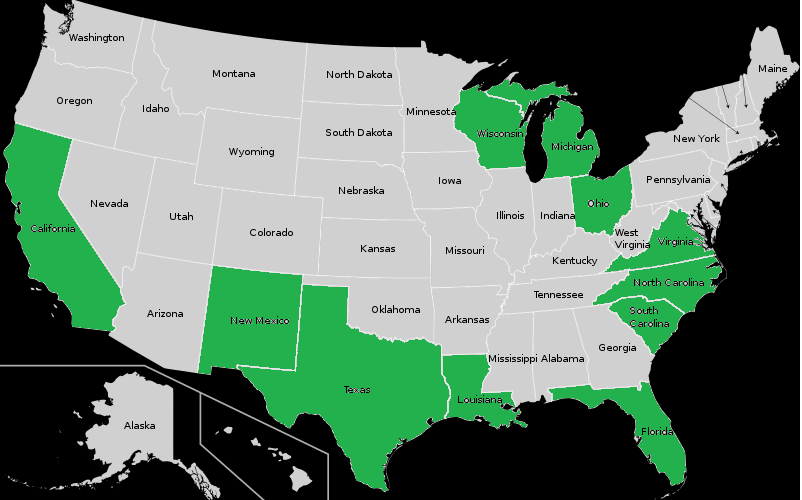
- California
- Florida
- Georgia
- Louisiana
- Michigan
- New Mexico
- North Carolina
- Ohio
- South Carolina
- Texas
- Virginia
- Wisconsin
Conclusion
Apart from the shore, much of Florida’s natural scenery is covered in dense pine forests and swampy marshes, which contribute to the state’s second-highest wild boar population in the nation. The beauty of winter hog hunting in Florida is in those acorns, aside from the fact that it is still the best time to hunt hogs in the State.
Preferably, the animals have gained weight and are appetizing to eat. They are much thinner than domestic swine, despite having so much fat. Cooler weather hunting has the added benefit of reducing the likelihood of spoilage in the meat. In order to prevent spoilage and pest infestation during the hot months, the meat needs to be processed and cooled very quickly.
